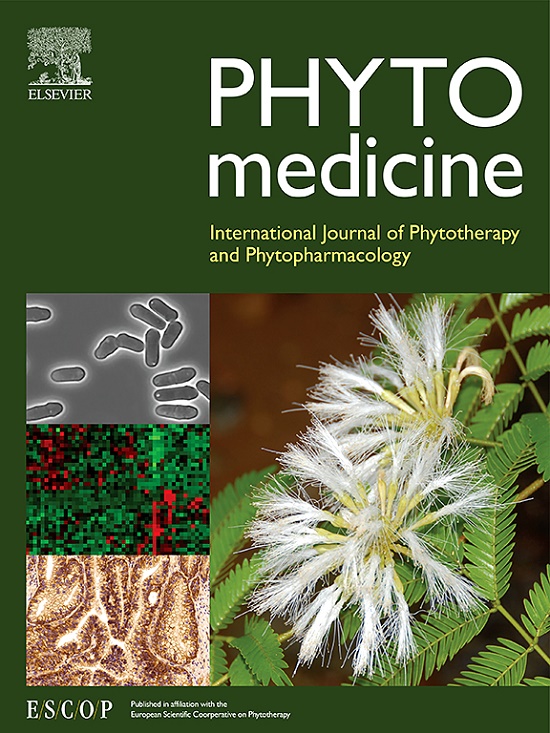Huoxue Tongluo tablet enhances atherosclerosis efferocytosis by promoting the differentiation of Trem2+ macrophages via PPARγ signaling pathway
IF 6.7
1区 医学
Q1 CHEMISTRY, MEDICINAL
引用次数: 0
Abstract
Background
Atherosclerosis (AS) serves as the primary pathological basis for various cardiovascular and cerebrovascular diseases. Impaired efferocytosis by macrophages within AS plaques exacerbates lipid metabolism disorders and inflammatory responses. Huoxue Tongluo Tablet (HXTL), a traditional Chinese medicine formula, has shown efficacy in treating AS and modulating macrophage function. However, its underlying mechanisms remain unclear. It is hypothesized that HXTL ameliorates AS by enhancing macrophage efferocytosis.
Purpose
To assess the efficacy and mechanisms of HXTL in treating AS at the single-cell level.
Methods
Ultra-high-performance liquid chromatography-mass spectrometry (UPLC-MS/MS) was used to analyze the constituents of HXTL. HXTL was administered to ApoE⁻/⁻ mice maintained on a high-fat diet. The progression of AS was evaluated by measuring atherosclerotic plaque area, necrotic core formation, collagen depletion, lipid accumulation, lipid profiles, pro-inflammatory mediators, and oxidative stress markers. Transcriptomic analysis was performed to explore the mechanisms underlying the therapeutic effects of HXTL on AS. Efferocytosis-related marker expression was evaluated using immunohistochemistry and quantitative PCR (qPCR), and the efferocytosis index was determined by the co-localization of apoptotic cells and macrophages. Efferocytosis inhibition was induced using Cytochalasin D. Single-cell sequencing was utilized to investigate alterations in Trem2⁺ macrophages following HXTL treatment. Trem2 expression was accessed by immunohistochemistry and qPCR, while flow cytometry and immunofluorescence staining confirmed the changes in Trem2⁺ macrophages. Bioinformatic analyses were conducted to investigate the mechanism through which HXTL enhances efferocytosis by regulating Trem2⁺ macrophage subsets. Western blotting and qPCR were used to assess the expression levels of PPARγ signaling, and the regulatory role of PPARγ signaling in macrophage subpopulation generation and efferocytosis function was accessed using GW9662.
Results
UPLC-MS/MS analysis identified 99 major components in HXTL. In vivo, medium and high doses of HXTL significantly reduced atherosclerotic plaque area, improved lipid profiles, decreased pro-inflammatory mediators and reactive oxygen species (ROS), and enhanced the efferocytosis function. Inhibition of efferocytosis reversed these beneficial effects. Single-cell sequencing and in vivo validation revealed that HXTL upregulated Trem2⁺ macrophages and efferocytosis-related genes. Bioinformatics and in vivo experiments demonstrated that HXTL activated PPARγ signaling, and inhibition of PPARγ signaling negated the pro-efferocytosis effects and the upregulation of Trem2⁺ macrophage upregulation induced by HXTL.
Conclusions
HXTL activates the PPARγ pathway, upregulates Trem2⁺ macrophages, and enhances macrophage efferocytosis, thereby ameliorating AS. This study is the first to demonstrate the regulatory effects of HXTL on macrophage subpopulations and its pro-efferocytosis activity.

求助全文
约1分钟内获得全文
求助全文
来源期刊

Phytomedicine
医学-药学
CiteScore
10.30
自引率
5.10%
发文量
670
审稿时长
91 days
期刊介绍:
Phytomedicine is a therapy-oriented journal that publishes innovative studies on the efficacy, safety, quality, and mechanisms of action of specified plant extracts, phytopharmaceuticals, and their isolated constituents. This includes clinical, pharmacological, pharmacokinetic, and toxicological studies of herbal medicinal products, preparations, and purified compounds with defined and consistent quality, ensuring reproducible pharmacological activity. Founded in 1994, Phytomedicine aims to focus and stimulate research in this field and establish internationally accepted scientific standards for pharmacological studies, proof of clinical efficacy, and safety of phytomedicines.
 求助内容:
求助内容: 应助结果提醒方式:
应助结果提醒方式:


